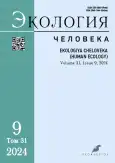Application of logistic regression in epidemiology: primary data, stratification and moving average
- Authors: Varaksin A.N.1, Shalaumova Y.V.2, Maslakova T.A.1
-
Affiliations:
- Institute of Industrial Ecology, Ural Branch of the Russian Academy of Sciences
- Institute of Plant and Animal Ecology, Ural Branch of the Russian Academy of Sciences
- Issue: Vol 31, No 9 (2024)
- Pages: 678-691
- Section: ORIGINAL STUDY ARTICLES
- URL: https://journal-vniispk.ru/1728-0869/article/view/314546
- DOI: https://doi.org/10.17816/humeco642576
- EDN: https://elibrary.ru/XXYJJP
- ID: 314546
Cite item
Abstract
Background: Logistic regression is the most commonly used method for establishing statistical relationships between quantitative predictors X and a dichotomous response Y (Y=0 or Y=1). Therefore, it is relevant to develop new approaches to the analysis of relationships between X and Y of this type.
Aim: To demonstrate the specific characteristics of the application of stratification, moving average and cumulative probability function methods in the construction and analysis of logistic regression models in the context of health risk assessment.
Materials and methods: The analysis of logistic regression models employs a range of statistical methods, including the stratification, moving average, cumulative probability function, goodness-of-fit tests, and proportion comparison tests.
Results: It is shown that the standard stratification methods are not sufficient for exploring the nature of the relationships between dichotomous Y and quantitative X. Additional methods, including moving average and cumulative likelihood function, facilitate the identification of features characterizing these relationships. The utility of graphical representations of logistic regression results in elucidating the statistical relationships between variables X and Y is demonstrated. The efficacy of the stratification, moving average and cumulative probability function methods is illustrated by examples from the field of epidemiology.
Conclusion: The combination of moving average and cumulative probability function methods with stratification enables the reliable identification of the nature of the relationship between dichotomous Y and quantitative X, as well as the potential for deviations from the conditions of applicability of logistic regression models.
Full Text
##article.viewOnOriginalSite##About the authors
Anatoly N. Varaksin
Institute of Industrial Ecology, Ural Branch of the Russian Academy of Sciences
Author for correspondence.
Email: varaksin@ecko.uran.ru
ORCID iD: 0000-0003-2689-3006
SPIN-code: 9910-2326
Dr. Sci. (Physics and Mathematics), Professor
Russian Federation, EkaterinburgYulia V. Shalaumova
Institute of Plant and Animal Ecology, Ural Branch of the Russian Academy of Sciences
Email: jvshalaumova@gmail.com
ORCID iD: 0000-0002-0173-6293
SPIN-code: 3163-6856
Cand. Sci. (Engineering)
Russian Federation, EkaterinburgTatyana A. Maslakova
Institute of Industrial Ecology, Ural Branch of the Russian Academy of Sciences
Email: t9126141139@gmail.com
ORCID iD: 0000-0001-6642-9027
SPIN-code: 3233-7652
Cand. Sci. (Physics and Mathematics)
Russian Federation, EkaterinburgReferences
- Ayvazyan SA, Yenyukov IS, Meshalkin LD. Applied statistics. Addiction research. Moscow: Finansy i statistika; 1985. 487 p. (In Russ.)
- Ayvazyan SA, Buchstaber VM, Yenyukov IS, Meshalkin LD. Applied statistics. Classification and reduction of dimensionality. Moscow: Finansy i statistika; 1989. 606 p. (In Russ.)
- Afifi AA, Azen SP. Statistical analysis. A computer oriented approach. Moscow: Mir; 1982. 488 p. (In Russ.)
- Siegel AF. Practical business statistics. Irwin: McGraw-Hill; 1999. 800 p.
- Hosmer D, Lemeshow S. Applied logistic regression. New York: Wiley & Sons; 2000. 373 p.
- Shoukri MM, Pause CA. Statistical methods for health sciences. Boca Raton: CRC Press; 1999. 384 p.
- Afifi AA, May S, Clark V. Computer-aided multivariate analysis. Boca Raton: Chapman&Hall/CRC; 2003. 512 p.
- Peng C-YJ, Lee KL, Ingersoll GM. An introduction to logistic regression. Analysis and reporting. J. Educational Research. 2002;96(1):3–14. doi: 10.1080/00220670209598786
- Wooldridge JM. Introductory econometrics: a modern approach. Mason: South-Western; 2009. 865 p.
- Schmidt CO, Kohlmann T. When to use the odds ratio or the relative risk? Int J. Public Health. 2008;53(3):165–167. doi: 10.1007/s00038-008-7068-3
- Bakhtereva EV, Shirokov VA, Varaksin AN, Panov VG. Assessing the risk of carpal tunnel syndrome exposure occupational factors. Ural Medical Journal. 2015;(10):9–13. EDN: VLMSTX
- Varaksin AN, Bakhtereva EV, Panov VG, et al. Risk factors for neurological diseases development in workers of Urals industrial plants: prognostic models based on discriminant analysis. Ecological Systems and Devices. 2016;(5):27–33. EDN: WMATKB
- Mikhelson AA, Lazukina MV, Varaksin AN, et al. Erosion of the vaginal mucosa in postmenopausal women with surgical correction of genital prolapse. Treatment and prevention. 2020;10(4);55–64. EDN: ZCTUDM
- Mikhelson AA, Lazukina MV, Varaksin AN, et al. Effects of preoperative preparation on the vaginal mucosa in women with genital prolapse associated with genitourinary menopausal syndrome. Acta Scientific Women's Health. 2023;5(4):83–97. doi: 10.31080/ASWH.2023.05.0494 EDN: UWBRGC
- Varaksin AN, Shalaumova YuV, Maslakova TA, et al. Application of moving average methods for the construction of regression models in medical and environmental research. Ecological Systems and Devices. 2020;(6):12–21. doi: 10.25791/esip.06.2020.1159 EDN: XTBFAV
- Maksimov DM, Maksimova ZV. Prevalence of smoking and hazardous drinking among industrial workers in the Sverdlovsk region. Ekologiya cheloveka (Human Ecology). 2021;28(3):34–41. doi: 10.33396/1728-0869-2021-3-34-41 EDN: ICGEPK
- Kretova IG, Vedyasova OA, Komarova MV, Shiryaeva OI. Analysis and forecasting of reserve capabilities of the organism of students according to indices of heart rate variability. Hygiene and Sanitation. 2017;96(6):556–561. doi: 10.18821/0016-9900-2017-96-6-556-561 EDN: ZAPEEB
- Konyrtaeva NN, Ivanov SV, Kausova GK, et al. Leech therapy in kazakhstan: patients’ characteristics and compliance with treatment. Ekologiya cheloveka (Human Ecology). 2016;23(2):42–48. doi: 10.33396/1728-0869-2016-2-42-48 EDN: VQGTMZ
- Kharkova OA, Grjibovski AM. Analysis of one and two independent samples using STATA software: parametric tests. Ekologiya cheloveka (Human Ecology). 2014;21(3):57–61. EDN: RYIEZL
- Tukey JW. Exploratory data analysis. Moscow: Mir; 1981. 693 p. (In Russ.)
- Glantz S. Primer of biostatistics. New York: McGraw-Hill; 1992. 440 p.
Supplementary files















